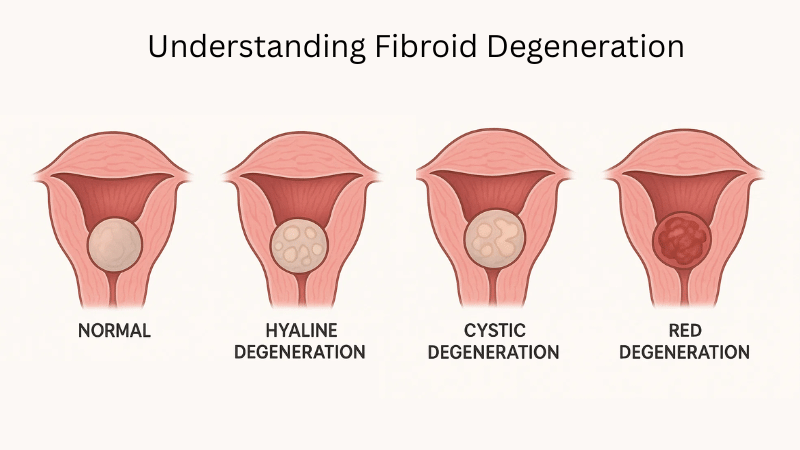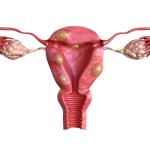
A degenerating fibroid, also known as a degenerative fibroid tumor, or degenerating uterine myoma, is when a fibroid outgrows the blood supply feeding it.
In simple terms, the fibroid becomes too large or grows too quickly for its own oxygen and nutrient supply to sustain it. Like all living cells, they must receive a constant supply of oxygen and nutrients to survive and grow through the blood vessels. When the body cannot build new blood vessels quickly enough, the tissue can’t get what it needs, and the tumor (fibroid) begins to break down. This process, known as fibroid degeneration, often leads to sudden, acute symptoms that can feel alarming.
While the symptoms are severe, fibroid degeneration is not rare. It is a common occurrence, especially when fibroids grow rapidly or become quite large. Factors like pregnancy, hormone changes, or specific treatments can accelerate this growth and increase the risk.
It’s important to understand what this process entails and how it feels because, while it’s temporary, professional medical care is necessary to manage the acute pain and confirm the diagnosis.
Is Fibroid Degeneration a Good Thing?
It’s easy to assume that “degeneration” is positive since it sounds like the fibroid might be breaking down and may not cause further symptoms. In reality, degeneration does not mean the fibroid is breaking down in a healthy way. Often, it indicates the fibroid has grown too large or too fast, dividing cells faster than the body can build new blood vessels (a vascular network) to feed the center of the mass. This cutoff of nutrients causes the tissue in the center to die, a process known as degeneration or necrosis.
Some degenerating fibroids resolve without lasting harm, but they can also lead to complications such as infection, severe pain, or misdiagnosis as another condition. That’s why a suspected fibroid degeneration should be evaluated by a specialist, even if the pain improves on its own.
What Does a Degenerating Fibroid Feel Like?
The primary symptom of degenerating fibroids is sudden, sharp abdominal or pelvic pain, often on one side. Some describe it as intense cramping or stabbing discomfort that is different from period pain. The exact experience varies depending on the cause of the fibroid, such as pregnancy.
Signs of a Degenerating Fibroid Tumor
If you aren’t sure whether you’re experiencing degenerating uterine fibroids symptoms, there are some warning signs you can watch out for.
These signs of a degenerating fibroid include:
- Persistent abdominal or pelvic pain unrelieved by usual period remedies
- Low-grade fever or nausea accompanying pain
- Visible bloating or pressure in the pelvis that worsens suddenly
- Unexpected bleeding or changes in menstruation
Since these symptoms overlap with conditions like ovarian cyst rupture or gastrointestinal issues, professional imaging and evaluation are necessary to prevent misdiagnosis.
How Long Does Fibroid Degeneration Last?
Pain from a degenerating uterine fibroid can last several days to a few weeks. Some people can improve within a few days with rest and pain management, while others need prescription medication or monitoring.
Since fibroid degeneration symptoms can resemble urgent medical conditions like appendicitis or an ovarian torsion, tracking pain and getting prompt medical evaluation are critical.
Types of Fibroid Degeneration
Not all fibroid degeneration is the same. Different patterns of tissue change result in distinct symptoms that require specific care and treatment.
Below is a quick-reference table summarizing the key types of fibroid degeneration:
| Type of Degeneration | Common Occurrence | Key Symptom or Feature |
| Red (Acute) Degeneration of Fibroid | Often during pregnancy | Sudden, severe localized pain |
| Hyaline Degeneration of Fibroid | Most common overall | Smooth muscle tissue replaced by a glassy, protein-like material |
| Cystic Degeneration of Fibroid | May follow hyaline | Fluid-filled cysts develop on the uterus and are visible on imaging |
| Calcific Degeneration of Fibroid | Often after menopause | Fibroid becomes hard, calcium-rich, and is typically less painful |
| Myxoid Degeneration of Fibroid | Very rare | Gelatinous consistency within the fibroid sometimes mimics cancer |
| Sloughing Degeneration of Fibroid | Rare, with submucosal fibroids | Tissue discharge through the cervix, cramping, and possible odor |
Is a Degenerating Fibroid the same as Sloughing?
A degenerating fibroid and sloughing are two different conditions. Degeneration refers to tissue breakdown caused by a lack of blood supply, while sloughing involves the fibroid tissue detaching and being expelled.
With sloughing, the dead tissue from degeneration detaches and is expelled, sometimes accompanied by a noticeable odor or discharge.
Do Degenerating Fibroids Need to Be Removed?
Degenerative fibroids don’t always need to be removed. In many cases, they shrink or stabilize after the acute phase passes.
However, treatment may be necessary if:
- Degeneration recurs
- Pain is severe or prolonged
- There’s heavy bleeding, infection, or other complications
A leading non-surgical option to treat fibroids is uterine fibroid embolization (UFE). UFE blocks the fibroid’s blood supply, causing it to shrink and preventing regrowth. Unlike surgery, it’s an outpatient procedure with no large incisions and a shorter recovery time.
Expert Care for Fibroid Degeneration
Sudden pelvic pain should be evaluated promptly. A clinician may order an ultrasound or MRI to confirm fibroid degeneration and rule out other causes. During this acute phase, management typically focuses on rest, hydration, and pain control (for example, NSAIDs) with close monitoring until symptoms improve.
Once the acute pain subsides, often within days to a few weeks, the next step is addressing the underlying fibroid to lower the chance of another episode and to relieve ongoing symptoms such as heavy bleeding or pelvic pressure. Elective options, including uterine fibroid embolization (UFE), are considered after the acute episode resolves.
USA Fibroid Centers offers minimally invasive, office-based UFE performed by interventional radiologists after the acute phase. UFE targets the fibroid’s blood supply to help relieve chronic symptoms and may reduce the risk of future degeneration, while preserving the uterus.
Already diagnosed with fibroids but not experiencing acute degeneration? An early consultation can help determine when watchful waiting is reasonable and when treatment is recommended. Proactive planning, including UFE when appropriate, may help prevent future degeneration and protect long-term quality of life.
If you are experiencing sudden pelvic pain or if you have known fibroids and want to discuss next steps, schedule a consultation today.
Degenerating Fibroid FAQs
Can fibroids degenerate more than once?
Fibroids can degenerate more than once, as the typical cycle of an untreated fibroid is to shrink and grow again. A degenerating fibroid can lead to more problems as the cycle repeats.
If a fibroid degenerates, does it mean it’s gone for good?
Fibroid degeneration doesn’t mean that the fibroid is gone for good. During fibroid degeneration, the fibroid will continue to shrink until it reaches a size that the blood supply can support, but it usually doesn’t disappear completely. Symptoms can ease and then return if the fibroid begins to grow again. Consult a fibroid specialist about treatments that block blood flow if flare-ups recur.



